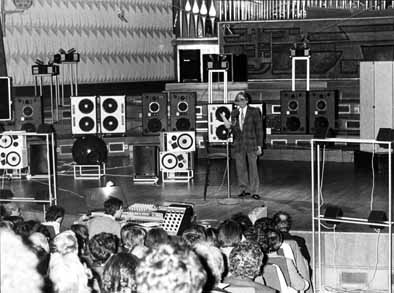

 |
 |
 ELECTRONIC MUSIC ELECTRONIC MUSIC |
| For centuries,
instrumental music had either been created by singing, drawing a bow
across or plucking taught gut or metal strings (string instruments),
constricting vibrating air (woodwinds and brass) or hitting or stroking
something (percussion). In the early twentieth century, devices were invented that were capable of generating sound electronically, without an initial mechanical source of vibration. As early as the 1930s, composers such as Olivier Messiaen incorporated electronic instruments into live performance. Recording technology was used to produce art music, as well. The theoretical basis of Musique Concrète as a compositional practice was developed by   Pierre Schaeffer, beginning in the early 1940s.The musique concrète was produced by editing together natural and industrial sounds (as noises made by trains): in addition to sounds derived from musical instruments or voices, it may use other sources of sound such as electronic synthesizers or Pierre Schaeffer, beginning in the early 1940s.The musique concrète was produced by editing together natural and industrial sounds (as noises made by trains): in addition to sounds derived from musical instruments or voices, it may use other sources of sound such as electronic synthesizers or sounds recorded from nature. Also, compositions in this idiom are not restricted to the normal musical rules of melody, harmony or rhythm. sounds recorded from nature. Also, compositions in this idiom are not restricted to the normal musical rules of melody, harmony or rhythm.In the years following World War II, some composers were quick to adopt developing electronic technology. Electronic music was embraced by composers such as Edgard Varèse, Karlheinz Stockhausen, Pierre Boulez, and Iannis Xenakis. In the 1950s the film industry also began to make extensive use of electronic soundtracks  . From the late 1960s onward, much popular music was developed on synthesizers. . From the late 1960s onward, much popular music was developed on synthesizers.Electronic music was once associated almost exclusively with Western classical music but from the late 1960s on the availability of affordable music technology meant that music produced using electronic means became increasingly common in the popular music. Today electronic music includes many varieties and ranges from experimental art music to popular forms such as electronic dance music.   In recent years, as computer technology has become more accessible and music software has advanced, interacting with music production technology is now possible using means that bear no relationship to traditional musical performance practices. In recent years, as computer technology has become more accessible and music software has advanced, interacting with music production technology is now possible using means that bear no relationship to traditional musical performance practices. In general, the term Live PA refers to any live performance of electronic music, whether with laptops, synthesizers, or other devices. A number of software-based virtual studio environments have emerged. Such tools provide viable and cost-effective alternatives to typical hardware-based production studios, and thanks to advances, it is now possible to create high quality music using little more than a single laptop computer. These advances have democratized music creation, leading to a massive increase in the amount of home-produced electronic music available to the general public via the internet.  |